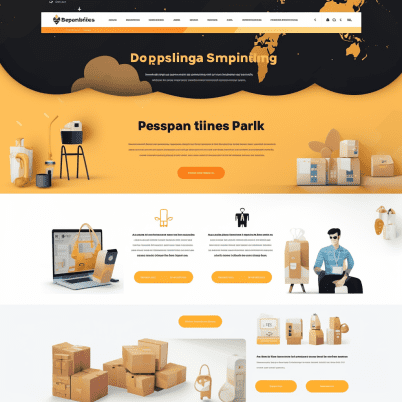Dropshipping business for sale in the rapidly evolving landscape of e-commerce, dropshipping has emerged as a promising business model, enabling entrepreneurs to harness the power of online retail without the need for substantial upfront investment in inventory. If you’re intrigued by the prospect of owning a Dropshipping business for sale, this comprehensive guide is your roadmap to navigating the intricate process of purchasing an existing one. In the following sections, we will explore every facet of this journey, providing in-depth insights and practical tips to ensure you make an informed decision.

Chapter 1: Understanding Dropshipping
What is Dropshipping?
At its core, dropshipping is an e-commerce business model that distinguishes itself by eliminating the need for inventory management. Instead of maintaining a warehouse stocked with products, the dropshipping business for sale dropshipper collaborates with suppliers or wholesalers who manage the inventory and fulfill orders on their behalf. When a customer places an order on the dropshipper’s online store, the supplier ships the product directly to the customer, streamlining the fulfillment process.
Advantages of Dropshipping
Low Overhead
One of the primary advantages of dropshipping is its minimal overhead costs. Unlike traditional retail models that require physical storefronts and substantial inventory, dropshipping business for sale operates in the digital realm, significantly reducing expenses.
Wide Product Range
With dropshipping business for sale, entrepreneurs can curate a diverse product range without the financial constraints associated with stocking inventory. This versatility allows for greater adaptability in catering to changing market demands.
Location Independence
The internet has erased geographical boundaries, enabling dropshippers to manage their businesses from virtually anywhere with an internet connection. This location independence offers tremendous flexibility and lifestyle benefits.
Scalability
Dropshipping business for sale can scale quickly and efficiently. As your business grows, you can easily expand your product offerings and customer base without the logistical challenges associated with traditional retail.
Challenges of Dropshipping
Thin Profit Margins
While dropshipping business for sale offers numerous advantages, profit margins can be relatively slim due to intense competition in the e-commerce space. Pricing strategies and cost management are critical to success.
Supplier Dependence
Dropshippers rely heavily on their suppliers’ reliability and performance. A breakdown in supplier operations can directly impact your business’s reputation and profitability.
Limited Quality Control
As a dropshipper, you have limited control over product quality and shipping times. Ensuring a consistent and positive customer experience can be challenging when you’re not handling the fulfillment process directly.
Chapter 2: Researching the Market
Before embarking on the journey of purchasing a dropshipping business for sale, it’s imperative to engage in comprehensive market research. A deep understanding of your niche and market dynamics will serve as the foundation for your future success.
Identify Your Niche
Selecting the right niche is a pivotal decision. Consider your personal interests, market trends, and profitability potential when choosing a niche. Conduct a SWOT analysis to assess your chosen niche’s strengths, weaknesses, opportunities, and threats.
Competitive Analysis
A thorough competitive analysis is dropshipping business for sale essential to understand your competitors’ strategies, strengths, and weaknesses. Tools such as SEMrush and Ahrefs can provide valuable insights into your competitors’ digital presence, keywords, and backlink profiles.
Keyword Research
Keyword research is a cornerstone of SEO (Search Engine Optimization) and dropshipping business for sale. Utilize tools like Google Keyword Planner or Ubersuggest to identify relevant keywords in your niche. These keywords will be instrumental in shaping your website’s content and SEO strategy.

Chapter 3: Finding Dropshipping Businesses for Sale
With a clear understanding of your target market and niche, you’re now ready to embark on the quest to find dropshipping business for sale that are available for purchase.
Online Marketplaces
Online marketplaces such as Shopify Exchange, Flippa, and Empire Flippers serve as excellent platforms to discover dropshipping businesses listed for sale. These platforms often provide valuable insights into the business’s performance, financials, and traffic.
Direct Outreach
In some cases, the ideal how to dropshipping business for sale may not be actively listed for sale. To unearth hidden gems, consider reaching out directly to dropshipping store owners who may be interested in selling but have not listed their businesses. LinkedIn and industry-specific forums can be invaluable resources for this purpose.
Due Diligence
Before finalizing any purchase, conduct rigorous due diligence on the dropshipping business for sale under consideration. Key areas to investigate include:
- Financial Statements: Review income statements, balance sheets, and cash flow statements to assess the business’s financial health and profitability.
- Traffic Sources: Analyze the sources of traffic to the website. Organic traffic from search engines is highly desirable, but also consider the effectiveness of social media, email marketing, and paid advertising efforts.
- Customer Reviews: Scrutinize customer reviews and ratings to gauge the quality of products and the overall customer experience.
Chapter 4: Evaluating a Dropshipping Business
With potential candidates in sight, it’s crucial to evaluate each dropshipping business for sale meticulously. This evaluation process will enable you to make an informed decision and mitigate potential risks.
Financial Metrics
Thoroughly examine the financial performance of the business. Key financial metrics to consider include:
- Revenue: Assess the consistency and growth trajectory of revenue.
- Expenses: Analyze operating expenses, marketing costs, and overheads.
- Profit Margins: Evaluate the overall profitability of the business, taking into account cost of goods sold (COGS).
Traffic Sources
Understanding the sources of traffic to the website is paramount. A diverse and sustainable traffic mix, including organic search traffic, social media referrals, and email marketing, is a positive sign. Evaluate the effectiveness of marketing strategies in driving traffic and sales.
Supplier Relationships
The strength of supplier relationships can significantly impact your dropshipping business for sale success. Assess the reliability of suppliers, the quality of their products, and the competitiveness of their pricing. Open lines of communication with suppliers are essential for addressing issues and ensuring smooth order fulfillment.
Customer Base
Analyze the existing customer base to gain insights into their demographics, behavior, and purchase history. A loyal and engaged customer base can be a valuable asset, as it can provide a stable revenue stream and opportunities for upselling or cross-selling.
Chapter 5: Negotiating the Deal
With a clear understanding of the business’s performance and potential, it’s time to initiate negotiations for the purchase. Effective negotiation is key to securing a favorable deal.
Price Negotiation
Negotiate the purchase price based on a thorough analysis of the business’s financials and growth prospects. Consider the following factors during negotiations:
- Historical Performance: Assess the historical revenue and profit trends.
- Growth Potential: Highlight the potential for growth through marketing improvements, expansion into new markets, or product diversification.
- Assets: Take into account any valuable assets included in the sale, such as domain names, social media accounts, or email lists.
Contract Terms
Once an agreement on price is reached, draft a comprehensive purchase agreement that outlines all terms and conditions of the sale. Key elements to include in the contract are:
- Payment Terms: Specify the payment schedule, including any down payments and installment arrangements.
- Assets Included: Clearly list all assets included in the sale, such as the website, domain name, customer database, and social media accounts.
- Contingencies: Define any contingencies, such as the transfer of supplier relationships and the successful transfer of ownership.
Escrow Services
Consider using an escrow service to facilitate a secure and transparent transaction. Escrow services protect both the buyer and the seller by holding funds in trust until all conditions of the sale are met.
Chapter 6: Post-Purchase Transition
Once the deal is successfully negotiated and finalized, the transition phase begins. Effectively managing this transition is vital to the continuity and success of the acquired dropshipping business for sale.
Ownership Transfer
Initiate the process of transferring ownership of the website, domain name, and other assets. This may involve technical tasks such as domain name transfers and hosting account access.
Supplier Communication
Introduce yourself to the existing suppliers and inform them of the ownership change. Establish a positive working relationship with suppliers to ensure a smooth transition of order processing and fulfillment.
Marketing and Operations
Maintain the existing marketing efforts and gradually implement any planned changes or improvements. Continuity in marketing campaigns and customer service is essential to maintain customer trust.

Chapter 7: Growing Your Dropshipping Business
With ownership secured and the transition underway, the focus shifts to growing and optimizing the ddropshipping business for sale long-term success.
SEO and Content Marketing
Invest in a robust SEO strategy to improve your website’s visibility in search engine results. Regularly create high-quality, informative content that provides value to your target audience. Incorporate the keywords identified during your earlier research to enhance your SEO efforts.
Social Media Marketing
Leverage social media platforms to engage with your audience and drive traffic to your website. Consider both organic and paid social media marketing strategies to expand your online presence and reach a broader audience.
Customer Service
Prioritize exceptional customer service to build trust and encourage repeat business. Promptly address customer inquiries and concerns, and actively seek feedback to continuously improve your service.
Expansion
Explore opportunities for dropshipping business for sale expansion. This could involve expanding your product catalog, exploring new marketing channels, or considering entry into new geographical markets. Each expansion should be informed by thorough market research and careful planning.
Chapter 8: Common Pitfalls and How to Avoid Them
While the prospect of owning a dropshipping business for sale is exciting, it’s important to be aware of common pitfalls and challenges that can arise in this dynamic industry. Here are some potential issues and tips to avoid them:
Poor Supplier Relationships
Maintaining strong and transparent communication with your suppliers is crucial. Address any issues promptly and maintain backup supplier options to mitigate risks associated with supplier performance.
Neglecting SEO
SEO is an ongoing process. Neglecting SEO efforts can lead to a decline in organic traffic and search engine rankings. Continuously update your website with fresh, SEO-optimized content to maintain your online visibility.
Ignoring Customer Feedback
Customer feedback is a valuable source of insights. Ignoring or neglecting customer feedback can result in a decline in customer satisfaction. Actively seek feedback and use it to make improvements to your products and services.
Chapter 9: Conclusion
Purchasing a dropshipping business for sale represents an exciting opportunity to enter the world of e-commerce or expand your existing portfolio. By following the comprehensive steps outlined in this guide, you can embark on your journey as a successful dropshipper with confidence.
In summary, the key steps to buying a dropshipping business for sale include:
- Understanding the dropshipping model: Familiarize yourself with the fundamentals of dropshipping business for sale.
- Conducting market research: Identify your niche, analyze competitors, and perform keyword research.
- Finding dropshipping businesses for sale: Explore online marketplaces and engage in direct outreach.
- Evaluating a dropshipping business: Scrutinize financial metrics, traffic sources, supplier relationships, and the customer base.
- Negotiating the deal: Negotiate the purchase price and contract terms, and consider using escrow services.
- Post-purchase transition: Facilitate the ownership transfer, communicate with suppliers, and maintain marketing and operations.
- Growing your dropshipping business: Invest in SEO, social media marketing, exceptional customer service, and consider expansion opportunities.
- Avoiding common pitfalls: Be vigilant about supplier relationships, prioritize SEO efforts, and actively engage with customer feedback.
Armed with this knowledge, you’re well-equipped to embark on your journey to become a successful dropshipper. Remember that success in dropshipping, like any business endeavor, requires dedication, ongoing learning, and adaptability in response to changing market dynamics. Your journey into the world of dropshipping begins here—best of luck! If you need any kind of best services for dropssiping business VISIT HERE.




